What's on the ASUS RT-AX88U and NETGEAR RAX80 - 2 the first Wi-Fi 6 router on the market
ASUS and NETGEAR have no information about having first-time users accept large sums of money for beta testing of the first 802.11ax / Wi-Fi 6 router. But now the two companies have return policies to help users have the opportunity to experience these new routers. Let's take advantage of that precious opportunity to test ASUS RT-AX88U router and NETGEAR's RAX80.
- Summary of the best Wi-Fi Router devices
Note : This is not a complete review of these two products as they are still in the final stages.
Review 2 ASUS Wi-Fi 6 routers RT-AX88U and NETGEAR RAX80
- Overview of two products ASUS RT-AX88U and NETGEAR RAX80
- The process of testing 2 routers
- Test results on 2.4GHz band
- Test results on 5GHz band
- Is 160MHz worth the price?
Overview of two products ASUS RT-AX88U and NETGEAR RAX80
Both ASUSGE's 802.11ax 2-band RT-AX88U AX6000 WiFi router and NETGEAR's Nighthawk AX8 8-Stream AX6000 are all built on the same Broadcom platform, ie Broadcom BCM49408 64bit 1.8GHz quad-core processor and two radios. BCM43684 4 threads support standard security / ac / ax.
ASUS RT-AX88UNETGEAR RAX80CP Broadcom BCM49408 64-bit 1.8GHz quad-core processor Broadcom BCM49408 64 bit 1.8GHzSwitchIn CPU + BCM53134 In CPURAM1024 MB 512 MBFlash256 MB 256 MB2.4GHz - Broadcom BCM43684 4-way radio standard support an / ac / ax- Skyworks SKY85216-11 2.4 GHz LNA (x4)
- Skyworks SKY85006-11 2.4 GHz PA (x4) - 4-channel Broadcom BCM43684 radio supports security / ac / ax5GHz- 4-channel Broadcom BCM43684 radio supports security / ac / ax
- Skyworks SKY85743-21 5GHz front end (x4) - 4-channel Broadcom BCM43684 radio supports security / ac / ax
The main difference between the two routers is the number of network ports and link integration support.The RT-AX88U has a WAN port and eight LAN Gigabit Ethernet ports, with LAN ports 1 and 2 supporting 802.3ad link integration.
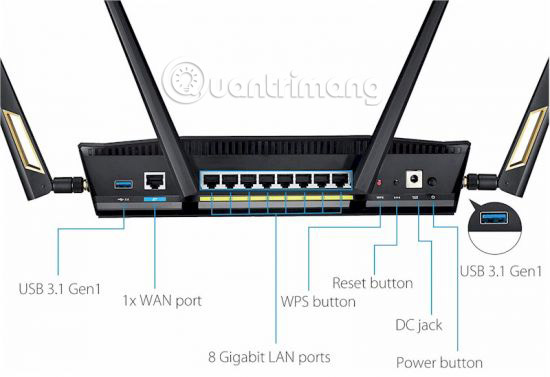
RAX80 has a Gigabit Ethernet WAN and five Gigabit LAN ports, but allows users to switch one of the LAN ports to WAN and integrate it (802.3ad) with a dedicated WAN port to work with some cable modems DOCSIS 3.1 also supports integrated ports.Users can also integrate 4 and 5 LAN ports.

Both products have two USB 3 ports, ASUS is USB 3.1 Gen 1 and Netgear is USB 3.0. RAX80 has a radiator fan and RT-AX88U does not.
In terms of the ability to broadcast Wi-Fi signals, both routers support channels UNII-2 and 2e DFS shown below (at least in the United States). This means that both products support adjacent 160 MHz channels (assuming you don't live near an airport or other radar stations). Note that the Broadcom structure does not support channel division of 160MHz (80 + 80). So, do not set the main channel to 149 or higher if you want the channel width to be 160MHz.
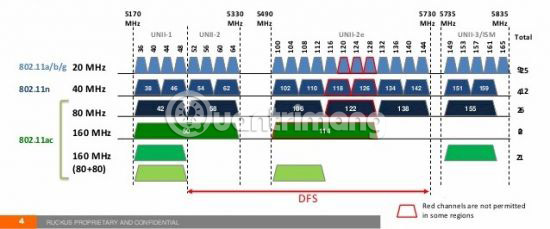
Both products allow users to disable HE frame information that 802.11ax requires. ASUS will ask users if they want to enable HE frame as part of the setup wizard, while NETGEAR will automatically disable this feature in Advanced Wireless settings. Unlike in the R7800 - the only 802.11ac router that supports 160MHz channels - RAX80 does not have HT 160 mode. If you want frames 160MHz wide, simply set the WiFi Mode selector to the Up to 4800 Mbps option (that's is new for NETGEAR's Genie GUI).
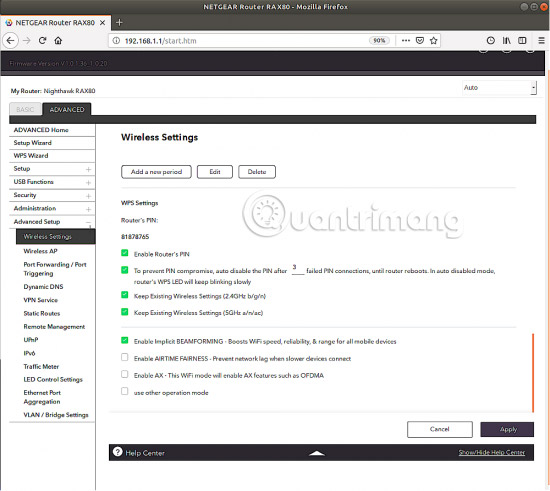
As mentioned before, high link speeds will only be achieved through four-threaded Wi-Fi devices. Currently, the only way to do this is to use an 11ax draft (test product) router that works in bridge mode. But now, to achieve that, users can choose one of these two products.
For those who own the latest generation 2-channel 11ac devices, it can be seen that the high link speed is the same as the current AC router, ie 867Mbps in the 5GHz band and 400Mbps in the 2.4GHz band ( Suppose the user can run with 40MHz wide channels in the 2.4 GHz band, but this is very unlikely in practice). Most users find that 173Mbps is the link speed on its leading 2.4GHz band.
If you want to try this new technology, you should own an Intel AC 9260 laptop or notebook. This is the only client that supports 160MHz channels and only supports two streams. It is also an 802.11ac device, so if near the router, the link speed can reach from 867 to 1733Mbps.
The process of testing 2 routers
The new 11ax standard is even more complicated than 802.11ac and is still witnessing rapid changes. Both ASUS and NETGEAR said the new firmware releases will be available soon.
The objective of these tests is to evaluate the performance of a two-threaded AC device (also known as Wi-Fi 5). The author does not conduct any tests to see if the products can reach a maximum link speed of 4804Mbps on the 5GHz band as advertised, as this is actually difficult to achieve. Any practical benefit from such bridge devices will also need a lot of traffic. OctoScope Pal-24 and Pal-5 devices have been used as test STA. Both are based on Qualcomm QCA9984 and support up to 256 QAM modulation.
This test uses firmware 3.0.0.4.384_5247-g499251e for ASUS and 1.0.1.36_1.0.20 for NETGEAR.
HE frames have been disabled on both products because they are not used by 11ac devices and may cause another potential problem at this time. For each product, the 2.4GHz band is set to Channel 6 and any setting creates a 40MHz channel. For the 5GHz band, Channel 40 is set as the main channel and any setting creates a 160MHz channel.
Each router is placed in the center of the turntable in the main octoBox 38 test chamber, as shown below. Two routers cannot be rotated during testing. A single iperf3 TCP connection with unlimited bandwidth has been used to generate traffic.
The only benchmark runs is Rate vs. Range (RvR). This test shows how the throughput (speed) changes when the signal level (range) changes. Instead of using physical distance to change the signal by moving the laptop around the house, the router is placed in a closed RF non-reflective chamber (octoBox) and the programmable RF attenuators used to change The signal (attenuator is an electronic device that reduces the power of the signal without significantly distorting its waveform). The diagram below describes the setup process.
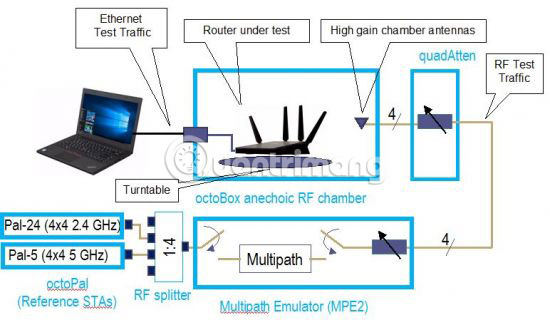
For 2.4GHz band, the attenuation is increased from 0 to 63dB in 3dB steps. For 5GHz band, the change range is 0 to 45 dB in the 3dB steps. Each test ran for 35 seconds (the first 5 seconds were removed from the average test level). The test order is:
- 5GHz downlink - 80MHz
- 5GHz - 80MHz Uplink
- 5GHz downlink - 160MHz
- 5GHz Uplink - 160MHz
- Downlink 2.4 GHz - 20MHz
- Uplink 2.4GHz - 20MHz
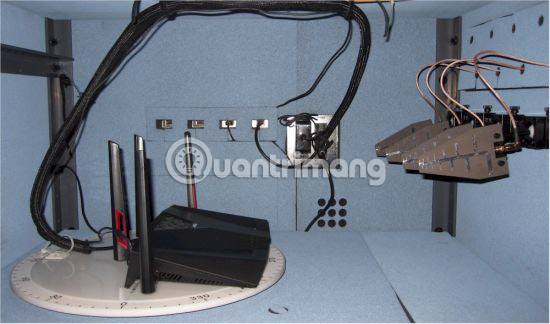
When testing addiction on 2.4GHz band, Pal STA bandwidth is set to 20MHz as above. This reflects a more typical reality of this band's performance, due to the 'crowded' space most users encounter.
For the 5GHz band, a test device has a Pal STA with a maximum limit of 80MHz and the other device is limited to 160MHz. So consider which device offers greater channel width advantage.
For reference, the author tested R7800 of NETGEAR again with software v1.0.2.60 and HT 160 mode is enabled. This is a four-threaded AC2600 router, supporting both DFS and 160MHz channels on the 5GHz band, using 802.11ac standard to support Qualcomm QCA9984 4x4 with MU-MIMO feature enabled on both bands (otherwise it will have to be purchased) Add an 11ax draft router that is equivalent to a four-threaded AC router that supports DFS channels and 160MHz channel bandwidth.
Test results on 2.4GHz band
Finding everything is easy on the 2.4GHz band. Note that these tests are done with 20MHz channel bandwidth.
In the downlink test, both AX devices yielded the same results as the R7800 based on AC with maximum throughput of about 10% (145Mbps), keeping stable until the signal strength decreased by 9dB. Both products also have a higher throughput than the R7800 at 63dB.
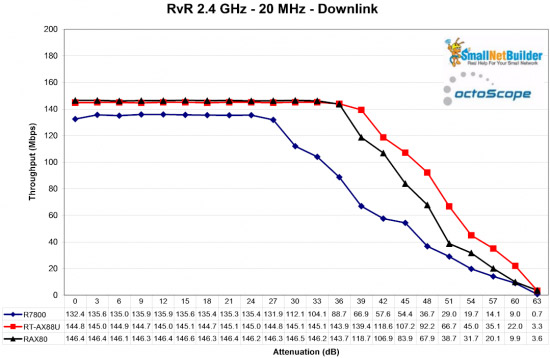
Uplink testing on the 2.4GHz band shows another result. This time, the R7800 and ASUS have the same maximum throughput of 130Mbps, but NETGEAR RAX80 only reaches 40Mbps. This is a bit confusing, especially because the Pal logs show that it is operating with RSSI of about -30dBm and Tx and Rx link speeds of up to 173 Mbps.
But if this router is restarted and tested before the downlink, it generates the same throughput as other routers. Therefore, the conclusion is that there is a bad point in adapting the RAX80 transmission rate. This will need to be fixed in the upcoming firmware update.
The bottom line is that there is an interoperability issue between Broadcom and Qualcomm. This was accidentally discovered because there are two differences from the normal test method.
First, the tested router is not rotated when the traffic is running during the test. This means to neutralize the difference in product antenna design and try to minimize the magnetic field effects near the small distance between DUT and STA. Rotation is done during the final test.
Second, Pal STA must not link backlink and uplink tests. Since the connection may be broken under high signal degradation, STA should be re-connected to ensure it is properly connected. This will also be done during the new testing process.
The low uplink throughput is caused by low packet aggregation of STA, when the attenuation is high (low signal level), then not reset to a high level of synthesis, when the level of degradation is set at low (high signal level) to start uplink check.
Re-linking the device between downlink and uplink testing causes the synthesis of packets to be reset.
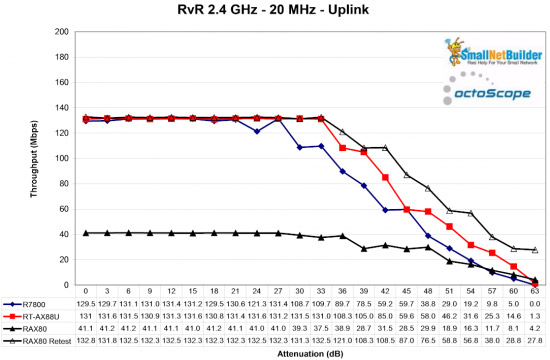
Test results on 5GHz band
Switching to the 5 GHz band, we will first consider the downlink with 80MHz channel width. First, the better AX router in this benchmark is ASUS because it has a slightly higher throughput than NETGEAR RAX80. More importantly, its throughput decreases less, at least until the signal attenuation reaches 30dB.
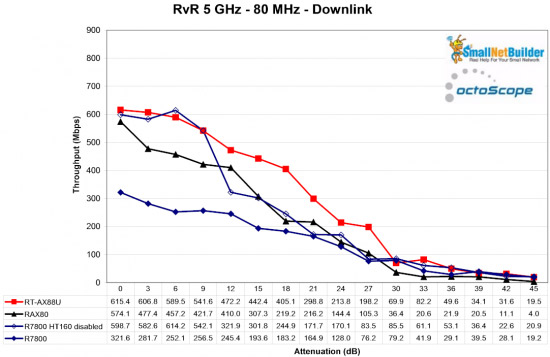
What about NETGEAR R7800? Once again we need to find out why its throughput is significantly lower. This time, HT 160 mode will be activated. When HT 160 is disabled, the R7800 works like other AX draft routers. This is not the same as other routers, including NETGEAR's RAX80, so NETGEAR will have to find new solutions in managing transfer speeds.
For uplink testing, NETGEAR R7800, both when HT 160 mode is and is not enabled, the traffic is up to nearly 600 Mbps. But ASUS, again, delivers the best performance for almost the entire range of test attenuation.
Low RAX80 throughput is caused by the same mechanism in uplink testing on the 2.4GHz band. The chart below shows the original uplink results and re-test results of RAX80, with the explanation above.
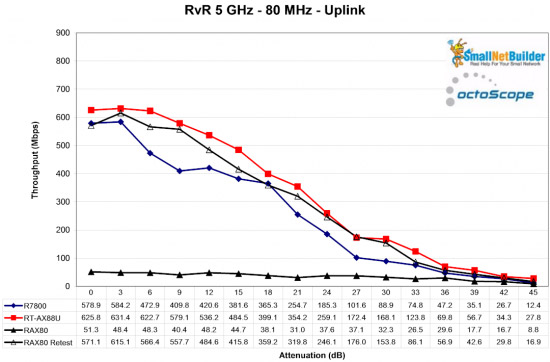
The last downlink chart shows all three routers operating as expected. ASUS RT-AX88U again gives the best results at higher signal levels (lower attenuation values). However, this time, it met its competitor R7800 and then surpassed the R7800 when it reached a 33dB decline.
The highest throughput of NETGEAR AX RAX80 is only slightly lower than ASUS. But its reduction is faster and still doesn't catch up with the other two routers in most of the tested range.
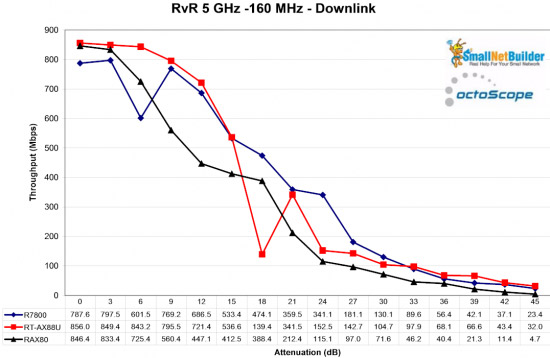
For uplink testing, it's hard to call the winner's name. But again, the last place seems to still be RAX80.
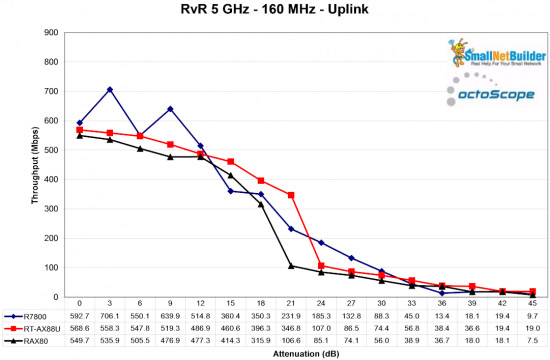
Is 160MHz worth the price?
As mentioned above, the 160MHz channel bandwidth is the main potential benefit that 11ax routers can provide at the present time, if the laptop has an Intel AC 9260 chip. The chart comparing the downlink results shows that R7800 (turned off HT 160 mode) has the best results. The best throughput (with 0dB degradation) of this group is 32% for R7800, 41% for RAX80 and 43% for RT-AX88U. And if you look at the chart, the best throughput advantage belongs to ASUS RT-AX88U (if 18dB attenuation is skipped) and NETGEAR R7800 (at about 24dB reduction).
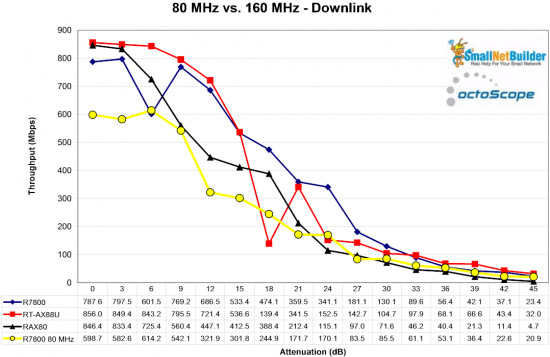
However, for uplink, it can be seen that there are very few advantages from larger channel widths.
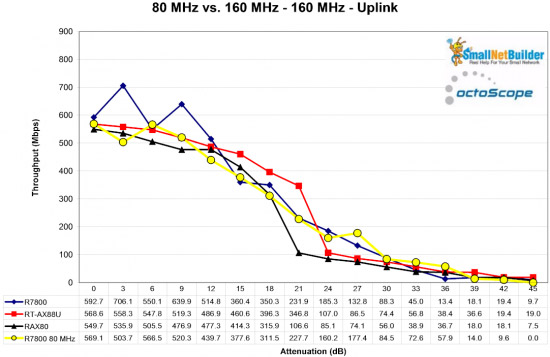
As mentioned earlier, this is not the stable performance of the first Broadcom-based Wi-Fi 6 routers in this market. Since both are based on the same Broadcom device, it is hoped that there will not be any significant difference in performance between the two devices.
Meanwhile, network equipment manufacturers, routers and IEEE ax research teams still have much to do in the near future.
See more:
- Linksys MR8300 - Mesh Mesh Wi-Fi for advanced users
- 8 best 802.11n routers in 2018
- The best gaming routers today
You should read it
- Top 5 best Netgear routers today
- Asus Zenbook 15 laptop review: Compact, comfortable keyboard
- Asus VivoBook S15 review: A great, comprehensive experience
- NTS exclusively distributes Netgear in Vietnam
- Asus VivoBook 14 laptop review: Meet the needs of everyday use
- Asus RT-AC68U Review: Versatile Dual Band Mesh WiFi Router
 How does the LAN switch (LAN switch) work?
How does the LAN switch (LAN switch) work? How to secure IoT device properly
How to secure IoT device properly How to turn Raspberry Pi into travel router with VPN
How to turn Raspberry Pi into travel router with VPN Top 6 best 3G / 4G mobile WiFi transmitters
Top 6 best 3G / 4G mobile WiFi transmitters 7 best 802.11g wireless broadband routers
7 best 802.11g wireless broadband routers 10 commands to master when working with Cisco IOS
10 commands to master when working with Cisco IOS